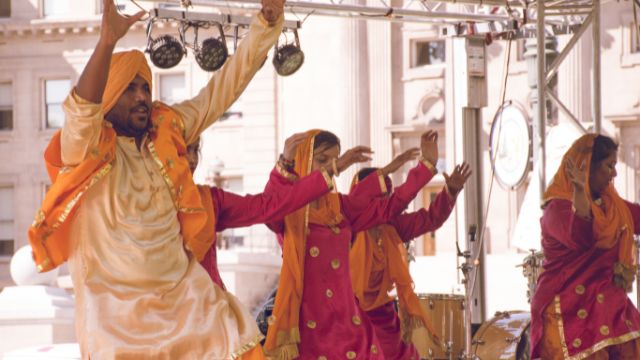Punjab boasts a diverse range of folk dances. Bhangra and Giddha are among the most popular. These dances have gained widespread appeal. Even non-Punjabis enthusiastically join Bhangra competitions. You might spot individuals from various backgrounds, like Europeans, Africans, or Chinese, embracing Punjabi dance and integrating it into their local culture. Here are the details about the different dance form styles of the Punjab:
Folk Dance Styles Of Punjab
Bhangra Dance

Initially linked to harvest celebrations, Bhangra has transformed over time due to modernization. Its music equipment and dance moves evolved, yet it retained its energetic essence with the traditional Punjabi Dhol and Jhanjhar, gaining popularity in various Indian states.
The Bhangra attire comprises a buttonless jacket with a Lungi and various-colored handkerchiefs. Dancers proudly wear the Pug (turban), a symbol of Punjabi heritage. Female performers don traditional Salwar-Kameez and Chunni, resembling male dancers’ attire.
Giddha Dance
Giddha is a lively dance performed by young women in Punjab, showcasing their strength and liveliness. It’s not confined to specific occasions but can be seen at various social events. The attire is simple, often regular household clothing with light decorations.
In Giddha, dancers move their shoulders, bend their lower body, and use clapping as a rhythmic element without any instrumental music. It’s usually performed in a large circle. The singing, “Boli or Biloyan,” is expressive and emotional. Giddha is a collective family performance where all the women participate, singing and dancing together, creating a beautiful presentation.
Jhoomer Dance
Jhoomer, known for its vibrancy and enthusiasm, originated from Balochistan and Multan regions. This dance has a slow and rhythmic tempo, where the word “Jhumur” signifies gentle swaying. Performances often revolve around themes of love and various emotions.
During the show, dancers enact an “ecstasy move,” imitating animal movements and activities like plowing fields, sowing seeds, and harvesting. Various forms of Jhumar exist, like Satluj Jhumar, Chenab Jhumar, Beas Jhumar, and Multani Jhumar. Among Punjab’s folk dances, Jhoomer is highly appreciated for its grace and elegance.
Malwai Dance
Malwai Giddha, a popular folk dance in Punjab, is primarily performed by unmarried men from regions like Bathinda, Muktsar, Ferozpur, Faridkot, Mansa, Sangrur, and Patiala. The dance incorporates various musical instruments, including the Chimta, a traditional South Asian percussion instrument commonly used in popular Punjabi Giddha and Bhangra music. Additionally, the Dholaki is another instrument used during the performance.
Sammi dance
Traditionally, Sammi dance is performed by women hailing from the Sandalbar area, which is now in Pakistan. These dancers wear vibrant kurtas and flowing lehengas, which are characteristic of the dance. The performance is often associated with a distinctive silver hair adornment, adding to its cultural significance and traditional attire.
Jaago Dance
The term “Jaago” indeed translates to “waking up” in a literal sense. During wedding festivities in Punjab, it’s a tradition for girls to perform a lively dance while carrying a pot (gaggar) adorned with lit candles. This dance procession parades through the village streets as the girls sing Jaagu songs. These songs often contain social themes and occasionally include playful teasing or mild mockery, often directed towards the elders in a light-hearted manner.
Gatka Dance
Gatka is not exactly a dance but a traditional martial art form from Punjab. It involves skilled handling of wooden sticks known as “gatkas.” Gatka is a martial art and carries cultural significance in Punjab.
During festivities like marriages, Gatka practitioners may perform impressive displays involving synchronized movements, twirling sticks, and coordinated actions, often to the beats of drums. Although it’s not strictly a dance, Gatka performances can be part of Punjab’s celebrations and cultural events.
Luddi Dance
Luddi, a traditional dance form in Punjab, is mainly performed by men. It involves energetic movements, including high jumps and spins. It’s commonly seen during celebratory events like weddings and is integral to Punjabi folk culture. These folk dances, including Luddi, carry unique styles, attire, and cultural importance, adding to Punjab’s rich heritage and diverse traditions.
Conclusion:
The diverse folk dances of Punjab, such as Bhangra, Giddha, Jhumar, Malwai Giddha, Sammi, and Luddi, showcase the vibrant cultural heritage of the region. Each dance carries its unique style, significance, and traditional attire, contributing to the rich tapestry of Punjabi folk culture. These dances embody the spirit, energy, and traditions passed down through generations, reflecting the essence of Punjab’s colorful and lively cultural landscape.
Santosh Kumar is a Professional SEO and Blogger, With the help of this blog he is trying to share top 10 lists, facts, entertainment news from India and all around the world.
